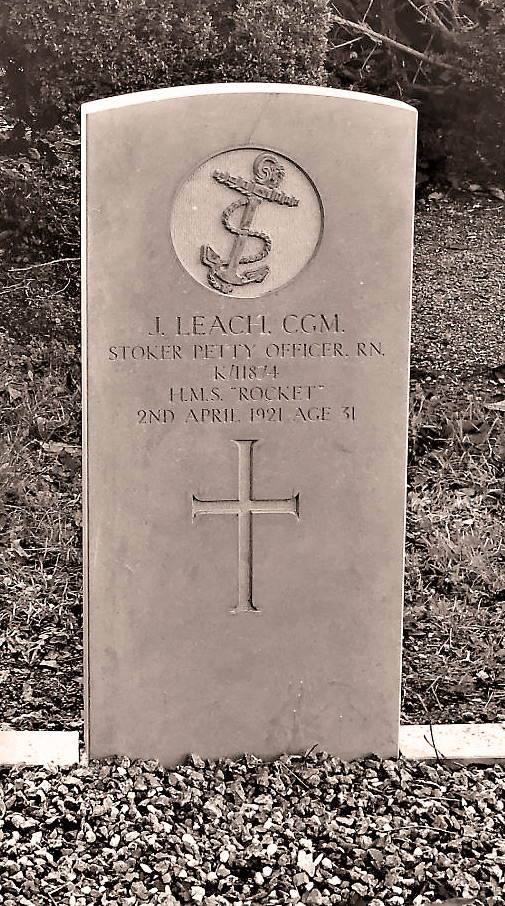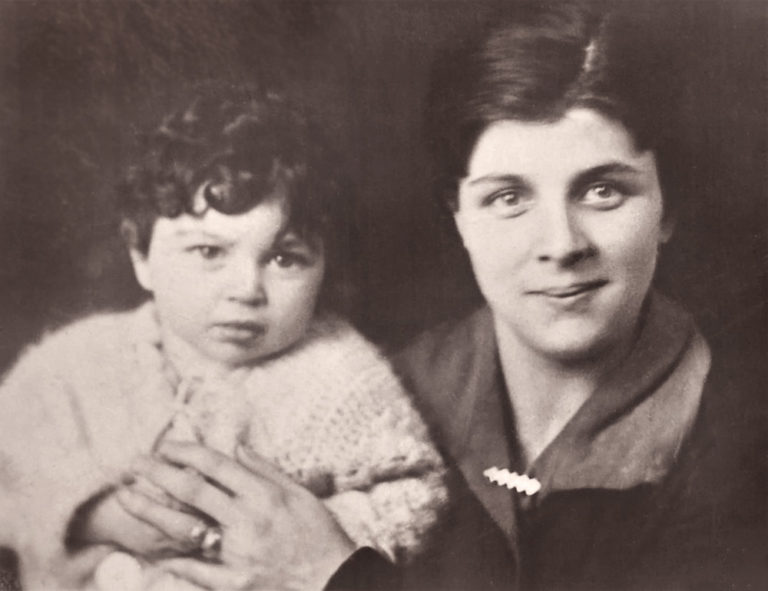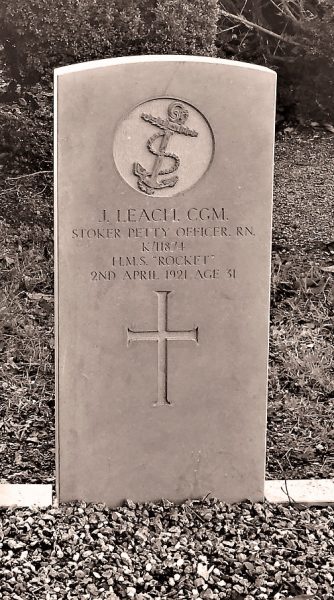James Leach CGM (1890-1921)
Stoker Petty Officer
HMS Rocket, Royal Navy, 1920

James Leach CGM
(1890-1921)
Stoker Petty Officer
HMS Rocket
Royal Navy, 1920



Royal Navy
Stoker Petty Officer
November 1920
James Leach is wearing the winter Class II, No. 1 Dress, the classic “Square Rig” of the Royal Navy. The badges in No. 1 Dress were in gold. Worn on the upper left arm, the rank badge of the Petty Officer was 2 crossed anchors surmounted by a crown. Below these were two ‘Good Conduct’ chevron stripes. Having been in the Navy since 1911, Leach qualified for 2 chevrons, which signified 8 years service (1 chevron was awarded for 3 years and 3 chevrons for 13 years).
On the right upper arm were worn distinguishing badges denoting branch and specialty. Again in gold on the No. 1 Dress. As a Stoker, James Leach was part of the Engineer Branch and wore its 3-bladed propellor badge. The stars above and below marked him as a Petty Officer.
James Leach (1897-1976)
Born: 22nd December 1890, Great Island, Kilmokea, County Wexford, Eire
Died: 2nd April, 1921, Great Island, County Wexford, Eire
James Leach was born at Great Island, Kilmokea, County Wexford on the 22nd December 1890, the son of John Leach, a labourer and part-time fisherman, and Kate Ryan (who died when he was 5 years old). James (or Jim as he was known) Leach joined the Royal Navy on the 7th July 1911, for a period of 12 years, with the number K.11874. He was not a tall man, being recorded as 5′ 5¼”, with dark brown eyes and hair and a dark complexion.
In February 1913 he joined the cruiser HMS Hyacinth, flagship of the Cape of Good Hope Station. In the early part of the Great War, Hyacinth was engaged in escorting convoys around South Africa and, in January 1915, was deployed to German East Africa to blockade the German light cruiser SMS Königsberg at the Rufiji Delta in what is now Tanzania.
Jim was made Leading Stoker, on the 25th June 1916, and posted to HMS Thistle on the 17th November 1916, still in the waters off German East Africa. Thistle was notable for being the last classic Victorian gunboat and the last British warship to retain a practical sailing rig. The ship’s log on the 11th June 1917, at 8.30 a.m., recorded that the vessel received a hit from a land-based German 4.1 inch shell through the port side ‘perforating the engine room bulkhead’ killing Engine Room Artificer 1st Class James Coxon and ‘wounding Stoker Leach in the leg’. As a result of his injury, Jim returned home to recuperate and the New Ross Standard of 30th November reported that he was by then ‘quite recovered’.
He was awarded the Conspicuous Gallantry Medal, listed in the London Gazette on the 19th December 1917. The citation read:
‘For conspicuous gallantry during the combined naval and military operations in the neighbourhood of Lindi, East Africa, on the 10th and 11th June 1917. Though wounded in two places in the legs, he showed exemplary conduct in continuing to stand by the engines (the engine-room artificer in charge having been killed) until ordered on deck for medical treatment.’
This was no mean achievement as only one hundred and eight of these naval medals, equivalent to the Distinguished Conduct Medal and second only to the Victoria Cross, were issued during the war.
On returning to duty, Jim Leach was posted to HMS Fisgard, a shore establishment used to train artificers and engineers at Portsmouth. In March 1918 whilst on home leave he became engaged to Helena or Lena, Kennedy. He was promoted to Stoker Petty Officer on the 1st of May and married Lena at Horeswood Church, Co. Wexford, on the 25th May 1918.
The gallantry medal was presented to Jim by King George V on the 8th June 1918. The Observer of 9th June reported that
‘The King, accompanied by the Queen and Princess Mary and the Duke of Connaught, held an investiture at Aldershot in the presence of thousands of spectators … The King shook hands with and congratulated the [250] recipients.’
Later that year, Jim was also presented with two French medals which in normal circumstances were not permitted to be worn on uniforms, however, the King, as recorded in the London Gazette gave special permission for these to be worn
“His Majesty the King has given unrestricted permission to the Officers and men concerned to wear the decorations in question”
The first was the Medaille Militaire, which was reported in the London Gazette of the 28th August 1918, conferred on Officers and men of the British Naval Forces, for services in the operations against Zeebrugge and Ostend.
The second was the Croix de Guerre, reported in the London Gazette of the 14th September 1918 ‘For distinguished services rendered during the war’.
After the end of the war, Jim served during the autumn of 1919 aboard HMS Princess Margaret as she laid mines to protect the port of Reval (now Tallinn, Estonia) from the Russian Navy.
In March 1920 Jim was posted to HMS Rocket, an R Class destroyer, and had the distinction of being chosen as part of the hundred-strong group of highly decorated members of the Armed Forces that formed the Honour Guard along the aisle of Westminster Abbey at the internment of the Unknown Warrior on the 11th November 1920.
This takes us into 1921, and the circumstances surrounding his death on April 2nd of that year. In March Jim was granted leave and returned home. These were troubled times. The Irish War of Independence was at its height, but to complicate matters a Miner’s strike was called on the 1st of April in England, precipitated by the return of the coal mines to private ownership on the 31st March, which move was brought about largely because of the rapid fall in coal prices in the context of a slump in economic conditions generally. On the back of this, the owners announced the slashing of miner’s wages by up to a half, which move was rejected by the miners who were then locked out of the mines by the owners. In turn, this resulted in the Government bringing its Emergency Powers Act, enacted in 1920, sending troops into the coalfields and even recalling troops from Ireland, despite the ongoing conflict, which brings us back to Jim Leach.
Jim Leach’s leave which still had 3 days to run was over – he was recalled to duty that day, a telegram ordered him to report to Devonport Naval Barracks immediately. He caught the mid-day train from Campile to Waterford to catch the Fishguard boat, the SS Great Western, which was due to sail at 5 pm that day. He apparently boarded the ship around 3.30 pm but never made it to Fishguard. He went overboard and drowned.
The circumstances of his death are somewhat confusing, but we know more facts about it, as at the time, in view of the ongoing conflict, the death of a member of the Forces was investigated by a military court in lieu of an inquest, which court of inquiry was held on the 26th April 1921. His body had not been found until the 24th of April, floating in the river at the junction of the Rivers Barrow and Suir, not far from the last sighting of him. Conflicting witness statements effectively made it impossible for the court to find a definitive answer, and it found that Jim Leach ‘accidentally fell overboard … No blame attaches to anyone’ and concluded that there was ‘not sufficient evidence to enable the court to form an opinion as to how the deceased came to be in the water’.
There had been a suggestion or inference that he had planned to go absent without leave by faking his death by jumping overboard, either because of the imminent birth of his second child or because of the prevailing political situation in Ireland. We will never know. Although he was thoroughly familiar with the area, the wearing of a uniform in such cold, wide and fast-moving waters would have made it difficult to swim to safety – if it had been planned it was done in haste and ended in tragedy. Jim’s second child was born the day after his body had been found – his wife had not been told of his death until after the birth.
James Leach's Medals

L to R: Conspicious Gallantry Medal, Medaille Militaire, Croix de Guerre
The Conspicious Gallantry Medal:
Instituted in 1874, an exclusively Naval Award, the CGM was awarded for gallantry in action for Petty Officers and seamen of the Royal Navy, including Warrant Officers and other ranks of the Royal Marines. It ranked below the Victoria Cross and, after its institution in 1914, above the Distinguished Service Medal.
The Medaille Militaire:
This medal, institute in 1852 by Louis Napoleon, was awarded to other ranks for meritorious service and acts of bravery in action against an enemy force. This French award was also awarded to foreign nationals serving with or alongside the French armed forces.
As an award for valour, it is the second-highest award ranking immediately after the Légion d’Honneur.
The Croix de Guerre:
This was created during the First World War to recognize French and allied soldiers who were cited for gallantry or courage during World War I, similar to the British “mentioned in dispatches”
James Leach (1890-1921)
Born: 22nd December 1890, Great Island, Kilmokea, County Wexford, Eire
Died: 2nd April, 1921, Great Island, County Wexford, Eire
James Leach was born at Great Island, Kilmokea, County Wexford on the 22nd December 1890, the son of John Leach, a labourer and part-time fisherman, and Kate Ryan (who died when he was 5 years old). James (or Jim as he was known) Leach joined the Royal Navy on the 7th July 1911, for a period of 12 years, with the number K.11874. He was not a tall man, being recorded as 5′ 5¼”, with dark brown eyes and hair and a dark complexion.
In February 1913 he joined the cruiser HMS Hyacinth, flagship of the Cape of Good Hope Station. In the early part of the Great War, Hyacinth was engaged in escorting convoys around South Africa and, in January 1915, was deployed to German East Africa to blockade the German light cruiser SMS Königsberg at the Rufiji Delta in what is now Tanzania.
Jim was made Leading Stoker, on the 25th June 1916, and posted to HMS Thistle on the 17th November 1916, still in the waters off German East Africa. Thistle was notable for being the last classic Victorian gunboat and the last British warship to retain a practical sailing rig. The ship’s log on the 11th June 1917, at 8.30 a.m., recorded that the vessel received a hit from a land-based German 4.1 inch shell through the port side ‘perforating the engine room bulkhead’ killing Engine Room Artificer 1st Class James Coxon and ‘wounding Stoker Leach in the leg’. As a result of his injury, Jim returned home to recuperate and the New Ross Standard of 30th November reported that he was by then ‘quite recovered’.
He was awarded the Conspicuous Gallantry Medal, listed in the London Gazette on the 19th December 1917. The citation read:
‘For conspicuous gallantry during the combined naval and military operations in the neighbourhood of Lindi, East Africa, on the 10th and 11th June 1917. Though wounded in two places in the legs, he showed exemplary conduct in continuing to stand by the engines (the engine-room artificer in charge having been killed) until ordered on deck for medical treatment.’
This was no mean achievement as only one hundred and eight of these naval medals, equivalent to the Distinguished Conduct Medal and second only to the Victoria Cross, were issued during the war.
On returning to duty, Jim Leach was posted to HMS Fisgard, a shore establishment used to train artificers and engineers at Portsmouth. In March 1918 whilst on home leave he became engaged to Helena or Lena, Kennedy. He was promoted to Stoker Petty Officer on the 1st of May and married Lena at Horeswood Church, Co. Wexford, on the 25th May 1918.
The gallantry medal was presented to Jim by King George V on the 8th June 1918. The Observer of 9th June reported that
‘The King, accompanied by the Queen and Princess Mary and the Duke of Connaught, held an investiture at Aldershot in the presence of thousands of spectators … The King shook hands with and congratulated the [250] recipients.’
Later that year, Jim was also presented with two French medals which in normal circumstances were not permitted to be worn on uniforms, however, the King, as recorded in the London Gazette gave special permission for these to be worn
“His Majesty the King has given unrestricted permission to the Officers and men concerned to wear the decorations in question”
The first was the Medaille Militaire, which was reported in the London Gazette of the 28th August 1918, conferred on Officers and men of the British Naval Forces, for services in the operations against Zeebrugge and Ostend.
The second was the Croix de Guerre, reported in the London Gazette of the 14th September 1918 ‘For distinguished services rendered during the war’.
After the end of the war, Jim served during the autumn of 1919 aboard HMS Princess Margaret as she laid mines to protect the port of Reval (now Tallinn, Estonia) from the Russian Navy.
In March 1920 Jim was posted to HMS Rocket, an R Class destroyer, and had the distinction of being chosen as part of the hundred-strong group of highly decorated members of the Armed Forces that formed the Honour Guard along the aisle of Westminster Abbey at the internment of the Unknown Warrior on the 11th November 1920.
This takes us into 1921, and the circumstances surrounding his death on April 2nd of that year. In March Jim was granted leave and returned home. These were troubled times. The Irish War of Independence was at its height, but to complicate matters a Miner’s strike was called on the 1st of April in England, precipitated by the return of the coal mines to private ownership on the 31st March, which move was brought about largely because of the rapid fall in coal prices in the context of a slump in economic conditions generally. On the back of this, the owners announced the slashing of miner’s wages by up to a half, which move was rejected by the miners who were then locked out of the mines by the owners. In turn, this resulted in the Government bringing its Emergency Powers Act, enacted in 1920, sending troops into the coalfields and even recalling troops from Ireland, despite the ongoing conflict, which brings us back to Jim Leach.
Jim Leach’s leave which still had 3 days to run was over – he was recalled to duty that day, a telegram ordered him to report to Devonport Naval Barracks immediately. He caught the mid-day train from Campile to Waterford to catch the Fishguard boat, the SS Great Western, which was due to sail at 5 pm that day. He apparently boarded the ship around 3.30 pm but never made it to Fishguard. He went overboard and drowned.
The circumstances of his death are somewhat confusing, but we know more facts about it, as at the time, in view of the ongoing conflict, the death of a member of the Forces was investigated by a military court in lieu of an inquest, which court of inquiry was held on the 26th April 1921. His body had not been found until the 24th of April, floating in the river at the junction of the Rivers Barrow and Suir, not far from the last sighting of him. Conflicting witness statements effectively made it impossible for the court to find a definitive answer, and it found that Jim Leach ‘accidentally fell overboard … No blame attaches to anyone’ and concluded that there was ‘not sufficient evidence to enable the court to form an opinion as to how the deceased came to be in the water’.
There had been a suggestion or inference that he had planned to go absent without leave by faking his death by jumping overboard, either because of the imminent birth of his second child or because of the prevailing political situation in Ireland. We will never know. Although he was thoroughly familiar with the area, the wearing of a uniform in such cold, wide and fast-moving waters would have made it difficult to swim to safety – if it had been planned it was done in haste and ended in tragedy. Jim’s second child was born the day after his body had been found – his wife had not been told of his death until after the birth.
James Leach's Medals

L to R: Conspicious Gallantry Medal, Medaille Militaire, Croix de Guerre
The Conspicious Gallantry Medal:
Instituted in 1874, an exclusively Naval Award, the CGM was awarded for gallantry in action for Petty Officers and seamen of the Royal Navy, including Warrant Officers and other ranks of the Royal Marines. It ranked below the Victoria Cross and, after its institution in 1914, above the Distinguished Service Medal.
The Medaille Militaire:
This medal, institute in 1852 by Louis Napoleon, was awarded to other ranks for meritorious service and acts of bravery in action against an enemy force. This French award was also awarded to foreign nationals serving with or alongside the French armed forces.
As an award for valour, it is the second-highest award ranking immediately after the Légion d’Honneur.
The Croix de Guerre:
This was created during the First World War to recognize French and allied soldiers who were cited for gallantry or courage during World War I, similar to the British “mentioned in dispatches”






